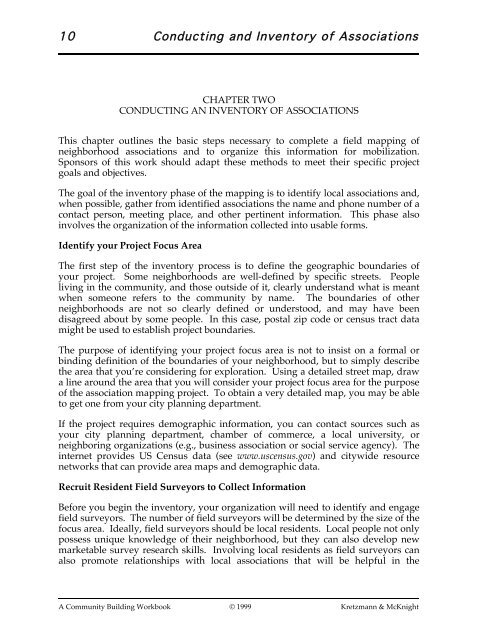A GUIDE TO MAPPING AND MOBILIZING THE ASSOCIATIONS IN LOCAL NEIGHBORHOODS
A GUIDE TO MAPPING AND MOBILIZING THE ASSOCIATIONS IN LOCAL NEIGHBORHOODS
A GUIDE TO MAPPING AND MOBILIZING THE ASSOCIATIONS IN LOCAL NEIGHBORHOODS
You also want an ePaper? Increase the reach of your titles
YUMPU automatically turns print PDFs into web optimized ePapers that Google loves.
10<br />
Conducting and Inventory of Associations<br />
CHAPTER TWO<br />
CONDUCT<strong>IN</strong>G AN <strong>IN</strong>VEN<strong>TO</strong>RY OF <strong>ASSOCIATIONS</strong><br />
This chapter outlines the basic steps necessary to complete a field mapping of<br />
neighborhood associations and to organize this information for mobilization.<br />
Sponsors of this work should adapt these methods to meet their specific project<br />
goals and objectives.<br />
The goal of the inventory phase of the mapping is to identify local associations and,<br />
when possible, gather from identified associations the name and phone number of a<br />
contact person, meeting place, and other pertinent information. This phase also<br />
involves the organization of the information collected into usable forms.<br />
Identify your Project Focus Area<br />
The first step of the inventory process is to define the geographic boundaries of<br />
your project. Some neighborhoods are well-defined by specific streets. People<br />
living in the community, and those outside of it, clearly understand what is meant<br />
when someone refers to the community by name. The boundaries of other<br />
neighborhoods are not so clearly defined or understood, and may have been<br />
disagreed about by some people. In this case, postal zip code or census tract data<br />
might be used to establish project boundaries.<br />
The purpose of identifying your project focus area is not to insist on a formal or<br />
binding definition of the boundaries of your neighborhood, but to simply describe<br />
the area that you’re considering for exploration. Using a detailed street map, draw<br />
a line around the area that you will consider your project focus area for the purpose<br />
of the association mapping project. To obtain a very detailed map, you may be able<br />
to get one from your city planning department.<br />
If the project requires demographic information, you can contact sources such as<br />
your city planning department, chamber of commerce, a local university, or<br />
neighboring organizations (e.g., business association or social service agency). The<br />
internet provides US Census data (see www.uscensus.gov) and citywide resource<br />
networks that can provide area maps and demographic data.<br />
Recruit Resident Field Surveyors to Collect Information<br />
Before you begin the inventory, your organization will need to identify and engage<br />
field surveyors. The number of field surveyors will be determined by the size of the<br />
focus area. Ideally, field surveyors should be local residents. Local people not only<br />
possess unique knowledge of their neighborhood, but they can also develop new<br />
marketable survey research skills. Involving local residents as field surveyors can<br />
also promote relationships with local associations that will be helpful in the<br />
A Community Building Workbook © 1999 Kretzmann & McKnight


